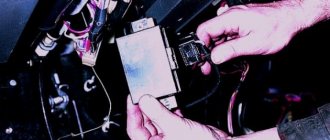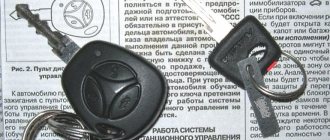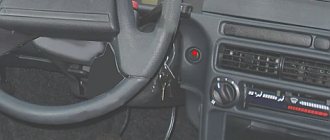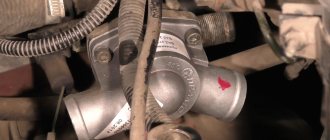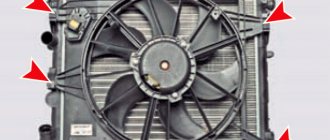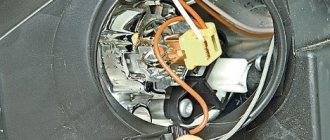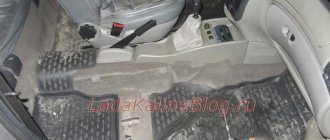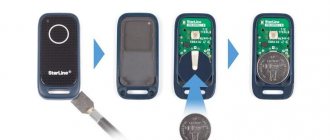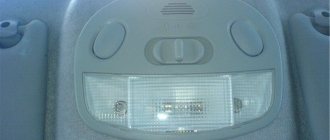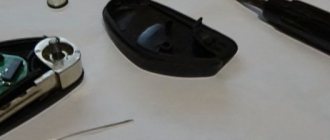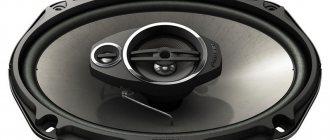I think no one will argue with me if I say that domestic cars are far from being comparable to foreign car brands. No one, not even the most patriotic person, will argue that the Lada Kalina is far from BMW or Mercedes.
Of course, it’s not the same price category at all, you say, but even cheaper foreign cars are usually superior to ours.
It's not a matter of beautiful design or a comfortable interior, but the fact that most of our cars can be sent straight from the assembly line for repairs.
So, you are the happy owner of a domestic car, and what should you do if yours, let it be a Lada Kalina, for example, does not start?
There are many reasons why a car refuses to start. Let's consider, of course, only the main ones, those that can be noticed and corrected on your own, the rest will be left to the “STO workers”, not because they also need to eat something, but because if you start fixing something that you don’t know how to fix, you can end up making it worse .
Repair gurus may pass by, this is a guide for the standard, average person, not a repair specialist, but at least who knows which side to grab the wrench by.
Immobilizer
The first reason why your Lada Kalina does not start, and which is easy to notice for yourself, is the immobilizer. If he blinked and beeped - sushi oars, sit down and read the manual. This problem is quite common and it is not easy to fix it, there is a lot of hassle, dancing with a tambourine and the like.
However, in the manual there is usually a decoding of the flashlight, which is illuminated by the light bulb - we count the seconds between flashes, the number of flashes, the number of buzzer signals - and look in the booklet what is written there about this.
In winter, it often happens that the car starts the fifth or sixth time . Most often this is solved by retraining the key, I won’t describe this problem, everything is in the manual, there shouldn’t be any problems.
Starter
If the immobilizer does not give alarm signals, but the engine does not start, the next reason may be the starter.
It’s easy to notice - there just won’t be the characteristic sound of a starting engine, all those “sneeze-sneeze-sneezes”. If the starter doesn’t turn, the engine won’t start, everything is clear here, and only a deaf person might not notice that the starter doesn’t turn.
So, we turn the key and... silence. The starter doesn't turn over, what could it be? The first reason is the battery. It may be discharged.
If the light bulbs and sensors on the panel do not light up in the cabin, this is immediately noticeable, but if everything is in order, but the starter does not spin, you can turn on the high beams and get out of the car, look at the headlights. If they shine dimly, then the problem is really in the battery; it has discharged, not completely, but to some critical level, which is not enough to start the starter.
Charge the battery or light a cigarette from someone and the problem will be solved, but if it is not the battery - that is, the headlights burn brightly and do not dim (sometimes immediately after turning on, they burn normally for 15-20 seconds and then immediately begin to dim), then you will have to tinker.
There may be two options here - wiring or the starter itself . To check the wiring, you can use a voltmeter (multimeter, in common parlance Tseshka) the red wire to the starter contact, the black wire to ground (car body, frame) should be about 12.5-14.5 volts.
If less or not at all means, then something is wrong with the wiring (of course, the key must be in the appropriate position).
You can clean the contacts, inspect nearby wires, check the fuses (most often the reason is in them), if this does not help, then we take our swallow to the service station, and they will find out what the reason is.
You can, of course, start the car from a pushrod, with the help of a couple of sympathetic neighbors or friends of strong build; this method is quite popular among the people for its simplicity. You can close the starter contact directly.
To do this, put the car in neutral, put the handbrake on just in case, and turn on the ignition. Then you can conduct current to the starter from some positive wire in the car, the main thing is that it is energized, from the headlights, for example, or light it from another battery (minus to ground, plus to the starter).
As soon as the wire is connected to the starter, it will usually start working and spin the engine shaft, then it’s easier. Of course, this is a one-time event for example, to get to the service station.
If, when checking with a multimeter, there is current in the wiring, but the starter does not work, then it has already broken down. If the starter clicks, but does not spin (does not buzz), then the starter motor is broken, if on the contrary, then the problem is in the retractor coil.
All this can be repaired, but it’s not that easy, you can’t do it on your knees, and you can write a separate article on repairing the starter. It would be easier, of course, to take it to a service station; they will most likely do it, but you may have to buy a new starter.
How to disable the immobilizer on Lada Kalina yourself
- Where is
- How to activate
- How to bypass the immobilizer on Kalina
- Bosch block M 7 4
- Bosch block 7 9 7
- Controller January 7 2
- Controller January 5 1
- Emergency shutdown
- Causes of malfunctions and solutions
The engine blocker used in VAZ cars may fail. In this case, the device stops responding to the owner’s commands or stopping the engine during a trip. Drivers often have a question about how to disable immobilizers on Kalina themselves.
Electronic control unit
Flooded ECU
Another common cause of problems with the Lada Kalina is the Electronic Control Unit, also known as the ECU, or the brains. In itself, it is a fairly reliable thing and if you don’t touch it, there will be no problems with it, but very often it turns out that it ends up flooded.
Yes, yes, this is the main problem with its malfunction. This often happens when antifreeze spills from the stove, since the unit is located almost under the radiator.
Often, when installing, say, an alarm system, when pulling wires into the interior, they forget to insert or insert the plugs poorly, and then splashes of water can get on the unit, which is also not good. It's useless to fix your brain.
Most often they will have to be changed; the only thing that can be done is to protect yourself from such a turn of fate by moving the control unit to another place.
No, you can, of course, wrap the block with plastic film or fill it with sealant, but in this case the brains will fail even earlier due to condensation that will inevitably appear inside.
It’s better not to risk it and move the brains somewhere under the glove compartment, for example, to do this we remove the plastic casing that is at the feet of the front passenger, on the left, remove the control unit from there - a flat metal box, and look for some safe place for it, of course the wires They're not particularly long, but they're long enough to hide the unit under the glove compartment.
In the updated Lada Kalina and Kalina 2nd generation, the ECU was moved to a different location, so this problem disappeared on new cars. But another one has appeared, if the drainage hole next to the cabin filter becomes clogged, then water through it during heavy rain gets to the ECU and almost the same thing happens. I advise you to check your water flow around the cabin filter more often!
How to disable the immobilizer with your own hands?
There is an option to temporarily disable the immobilizer, which may be required when installing an alarm system with auto start.
To install the bypass system, use:
- A control unit with a key or tag embedded in it. A key or chip is inserted into a device located deep in the dashboard. When autostart is activated, the alarm relay activates the unit and the engine starts, bypassing the main circuit.
- Blockless immobilizer bypass unit. A separate control device is installed that emulates an ignition key with a chip.
Another way to disable the immobilizer on Kalina depends on the type of ECM (control unit).
Bosch M7 4 block
Before you begin performing an operation on a car with a Bosch M7.4 unit, you must prepare:
- a computer or laptop with Winflashecu v.1.14 preinstalled (the distribution is available for free download);
- adapter and cord K-Line, for example, VAG-COM 409.1;
- pre-downloaded software for the unit with disabled immobilizer support;
- several wires with different lengths.
To disable the immobilizer on Kalina, you need to perform the following steps:
- Remove the wires from the battery terminals and disconnect the wiring harness connectors from the ECM installed under the hood of the vehicle. To disconnect, you need to remove the protective top cover and pull out the flat connector lock. All work is carried out on a large block. The small block can not be disconnected from the block.
- Insert the wire into contacts A4 and B2 from the harness side. These cables will be used to supply additional 12 V positive voltage. To do this, they are connected to the battery terminal through an intermediate switch.
- Reinstall the connector and fasten the fastener.
- Connect the adapter to the diagnostic connector located in the passenger compartment. The connector is located under a plastic cover installed on the center console.
- Set the data transfer rate to 38400 bps in your computer settings.
- Launch the Winflashecu application and select the port number, speed (38400 bps) and block type M7.4 in the dialog box. In the lower right corner of the window there will be a message “No connection”.
- Apply additional power to pins A4 and B2.
- Turn on the ignition. The “No communication” notification should change to “Communication with the ECU” and the buttons for starting operations will become active.
- Read the EEPROM (unit software) data and save it to the computer's hard drive.
- Select new software and load it into the unit’s memory using the “Write EEPROM” button.
- Wait for confirmation that the download was successful.
- Close the program and turn off the ignition.
- Remove the auxiliary power wires.
- Check whether the car can be started with a key without a chip. The immobilizer symbol will light up in the instrument cluster when starting and go out after a few seconds.
Candles
If the electronics are fine, there are still a lot of options why the engine won’t start. A common reason is that the candles are simply flooded.
Most often, candles are flooded in winter . Compression in the cold does not correspond to the parameters, so the engine does not start immediately. Often the spark plugs flood due to a weak battery that does not produce a normal spark, the wiring or the spark plugs themselves.
The easiest way to dry the spark plugs is to simply press the gas all the way to the floor and turn the engine with the starter for a few seconds (10-15). If there is nothing serious, then, as a rule, it will start (it rarely helps in winter), but if not, you will have to dry the spark plugs.
To do this, they need to be pulled out, cleaned of carbon deposits, for example with a toothbrush, the main thing is that the gap remains the same ( 0.8-1mm ), and then dried. You can use a hair dryer or even an oven if you are in a hurry.
Prudent drivers keep a spare set of spark plugs in the car for such cases. In order not to have to go to work in a minibus in the morning and not bother with drying, you can simply screw in spare candles, and in the evening, after work, calmly dry the main ones.
To reduce the risk that the spark plugs will be flooded, you need to constantly monitor the battery so that it is always charged and every two to three days, while driving, load the engine for 10 seconds to 4500-5000 rpm so that it cleans itself of carbon deposits and all sorts of deposits in the chamber.
Poor quality fuel
Spark plugs can also flood due to bad gasoline. This is another reason why the engine does not start. Very often, condensation forms in winter and clogs the coarse filter. To avoid this, periodically add pure alcohol to the tank in winter.
It smokes, sneezes, smokes like a snake Gorynych, this often happens in our time, but, as a rule, people have some remnants of conscience and they try not to reduce gasoline to a non-flammable state.
The car can even run on this kind of gasoline, the only problem is that it is absolutely not useful for the engine. To avoid this, refuel at large chain gas stations.
They, as a rule, monitor their reputation and do not allow this to happen, but if it turns out that you have filled in burnt gasoline, and even so much that the car does not want to start, you can drain the gasoline and fill in another, road gas, or if there is not much left , you can fill in more good 95 gasoline and its mixture with palenka will be more or less normal.
Of course, there are severe cases when filters and injectors become clogged and they have to be washed out for a long time and tediously (or whatever is easier to change), but this happens mainly when buying gasoline from some garage “oil workers”.
It’s quite easy to protect yourself from them - just refuel at trusted places and under no circumstances buy gasoline from any garage gas dealers. In principle, they are not such a common occurrence now, but they still occur, and people buy gasoline from them because it is cheaper, but it is better not to do this, the stingy pays twice - an immutable truth.
And if you really had to buy such a piece of water, at least filter it, there is no need to clog the filter with nozzles.
Immobilizer Kalina
- Like
- I do not like
student 06 Aug 2010
I ran into a problem with viburnum.
Kalina 1.6 8V, late 2006 (I don’t know which ECU, so I’m reporting this data).
At first there was a problem that the car did not open the first time with the key fob. It closes easily, but opens with difficulty—you have to press the button many times. I thought it was the battery, I changed it, it didn't help. Then I noticed that when the car was armed, the icon of a car with a key blinked on the dashboard. That is, you close it as usual, and the indicator blinks.
The key fob was registered again, but nothing changed.
I don’t know what to do with this, because opening the car becomes problematic.
Who fumbles about immobilizers - tell me what it is and what it comes with.
The alarm system is standard, the immobilizer is standard, nothing has been changed.
- Like
- I do not like
sonnic Aug 07, 2010
I ran into a problem with viburnum.
Kalina 1.6 8V, late 2006 (I don’t know which ECU, so I’m reporting this data).
At first there was a problem that the car did not open the first time with the key fob. It closes easily, but opens with difficulty—you have to press the button many times. I thought it was the battery, I changed it, it didn't help. Then I noticed that when the car was armed, the icon of a car with a key blinked on the dashboard. That is, you close it as usual, and the indicator blinks.
The key fob was registered again, but nothing changed.
I don’t know what to do with this, because opening the car becomes problematic.
Who fumbles about immobilizers - tell me what it is and what it comes with.
The alarm system is standard, the immobilizer is standard, nothing has been changed.
I hasten to tell you the good news, if your car is under warranty, then you screwed it up by throwing out the battery that was from the factory, just last week I was in Samara Lada with a similar problem, everything was fixed by replacing the key fob under warranty.
ps the key fob works correctly only with a standard battery (words from an engineer under warranty)
- Like
- I do not like
Cooper Aug 07, 2010
Gasoline pump
Sometimes it happens that the fuel pump is capricious. Again, often during the cold season. The starter works, but the engine does not start, you cannot hear the fuel pump pumping, and sometimes the exclamation mark flashes.
To check whether there is pressure in the system, you need to open the hood, on the left, on the injector ramp, unscrew the black cap. There will be a nipple there, like in tires, if you press it, it should spray.
If it splashes, then it’s not the fuel pump, but if not, then we’ve found the culprit. As a rule, after recharging the battery, the fuel pump starts working, but if not, we look for the reason.
Often the relay is to blame. In the transmission tunnel, on the passenger side, we unscrew the casing, in the same place where we unscrewed it when we transferred the brains. There will be several power coils, three usually, you just need to tap them or warm them in your hands.
You also need to check whether the ECU is flooded, but if it is moved, as mentioned above, then this is not the reason. The best option is of course a service station. This is always the best option, but it costs money, so it’s better to do everything described above, in case there’s some little thing that can be corrected on your own.
You can get to the fuel pump yourself, it’s located under the rear sofa, fold it back, unscrew 4 screws and there it is, first remove the connector, take a multi-meter or a light bulb with two wires (test), insert contacts on the black and gray wires, turn with the starter, The lamp should be on and the multi-meter should show approximately 12V.
Having made sure that the voltage reaches the fuel pump, but it does not work, we quickly remove it and inspect it, perhaps the coarse filter has iced up (in winter), but if not, then we change it.
If the lamp does not light up and the multi-meter refuses to show the treasured 12V, go to the front seats, open the plug where we have the ECU diagnostic connector and there are 3 fuses, check them, and at the same time look at the relay, as described just above.
timing belt
A terrible problem that occurs with viburnum is a broken timing belt. It is impossible not to notice this problem. It doesn’t happen that you start the car in the morning and the belt is broken.
No, the belt breaks while moving and nothing good can happen here. The valves meet the pistons and bend them, and the entire piston can often break apart, which can lead to expensive repairs.
These are all 16 valve engines; eight valve engines do not have such consequences, because the pistons have recesses for the valves, and it is these recesses that help avoid collisions between the valves and the pistons.
No one is safe from a belt rupture, just check it more often, then you can notice the threat of a rupture and replace the belt that threatens to break in time. There is also an option to install pistons with grooves in a 16-valve engine, this will also help avoid serious consequences if the belt breaks.
Another problem - the pulley turned. Occasionally it happens that it turns over two or three teeth, because of this the sensor shows the wrong phase and the engine does not start. You need to remove the belt and check whether the mark on the pulley and the rear cover of the timing belt matches.
If not, then you need to turn the pulley (in rotation) until the marks match. The work is troublesome, you need to disassemble a lot of things to get where you need to, you also need to keep track of the marks on the camshaft and crankshaft, in general there is a lot of fuss.
Causes of malfunction
Let us list the reasons for the occurrence of such a phenomenon as a non-working starter and a flashing immobilizer. First, it’s worth noting that it all depends on the intensity of the blinking, but let’s take the most common concept. So, the reasons for the malfunction:
The most deplorable and fatal option is the ECU burned out. This usually happens because liquid has gotten into it.
Inspection of the ECU on Kalina
It is best to determine all these reasons at a car service center, since this is not often possible with your own hands.
ECU burned out
The insides of the ECU block are filled with antifreeze, we are trying to fix it
If the ECU burns out, then you can “dry your oars” because the owner ended up with a substantial amount of money. Often, this happens due to the fault of the motorists themselves, who try to install additions to the car themselves, or simply spill coffee on the dashboard.
This malfunction can be treated by replacing the control unit and updating the firmware. The procedure is expensive, so it is recommended to treat the car carefully, especially inside.
The most important problem is that there is a design flaw: the ENGINE CONTROL UNIT is installed in such a way that if the hood seal leaks, it floods with water. And the block “comes to a halt.”
To prevent this from happening, we recommend that you move the engine control unit to another location, higher, under the panel.
Ignition key and lock
Out of sync ignition keys. Key training will be required
A malfunction of the key or ignition switch can only be treated in one way - by replacing them. In this case, you will have to flash the same car control unit. This is not a critical malfunction, but it will cause trouble and hassle.
Crankshaft sensor
Sometimes it happens that the car starts normally when cold, but if you turn off the engine and after some time try to start it again, nothing will work.
Sometimes the car just won't start. The starter works, the fuel pump pumps, the spark plugs and brains are in order, in this case you should check the crankshaft sensor, perhaps it is gradually dying.
To do this, remove the sensor, connect a multi-meter to the connectors in voltmeter mode and quickly pump it in front of its end with a screwdriver; there should be voltage surges.
Another way is to remove the sensor and measure its resistance, with the same multi-meter, set it to a continuity test and ring the two contacts of the sensor, it should show approximately 750 Ohms
If there are no jumps, change the sensor. If there are surges, you can try to check if there is dust or dirt under the sensor, if the end is dirty; if after cleaning the engine still does not want to start, we try to install a new sensor, since it is quite inexpensive.
If after installing a new sensor the situation has not improved, then it is not the problem. Another easiest way to determine that the sensor is faulty is to look at the tachometer; as a rule, if there is a fault, the speed does not twitch when trying to start.
Immobilizer design elements
How to understand why the immobilizer blocked the engine from starting? What to do in this case? First you need to understand how it works and identify its main structural elements.
The main component of the immobilizer is the electronic control unit. Its functionality is provided by a microcircuit that is programmed for a specific action program. The chip contains a special exchange code that is used when “interrogating” the car key. There is also a coil inside that reads information from the key.
The second important element is the actuator, which contains several electromagnetic relays. As soon as the electronic unit issues a command, the switching mechanisms break the chains of signals that go to important elements of the car. If desired, you can connect an additional electromagnetic system that will block non-electric devices.
The third element is the transponder, which is a programmed chip. It is in every key that is inserted into the ignition. This transponder transmits a unique code to the vehicle system, upon recognition of which the control unit gives permission or refusal to start the engine.
Ignition coils
If everything possible has been checked, but the car won’t start, and you don’t want to take it to the service station until you’ve tried everything that you can try to fix it yourself, check the ignition module (coil).
First, let's check the wiring. We disconnect the block of wires from the coil, connect the middle wire to the plus of the multimeter (in voltmeter mode), and connect the minus of the multimeter to ground.
If, when you turn on the ignition, a voltage approximately equal to the battery voltage appears, then everything is in order with the power supply; we check the control circuits.
To do this, connect a multimeter to the middle and one of the outer wires of the harness and turn the crankshaft with the starter - a voltage of a couple of volts should appear, similarly with the other outer wire. If the wiring is normal, check the coil.
Customized ignition coils
We switch the multimeter to ohmmeter mode, connect the tester to the middle and one of the outer terminals of the coil, if the circuit shows infinity, then that’s it - an open circuit. Same with the other extreme conclusion.
If everything is in order, we continue. We check the secondary winding - to do this, the coil must be removed from the engine and turned over. We connect the tester to the paired coil connectors - cylinders 1-4 or 2-3.
If it shows something other than infinity (should be something around 4 kOhm) then everything is fine, there is no break. Same thing with the other couple.
Bottom line
In general, these are the main reasons why the engine may not start, or rather there are many more reasons, but these are the main ones that you can fix with your own hands.
I will say again that you can only try to do something if you at least approximately know what and how to do.
You don’t need to be an extra-class master; you must have some experience in metal tinkering behind your shoulders, straight arms and a good mind.
If you have all these components, you will succeed, and in the event of a minor breakdown you will be able to save on repairs; after all, it’s a pity to pay your hard-earned money to replace fuses or something that you can do yourself.
What exactly is an immobilizer?
How is this device different from a conventional security system? First of all, the degree of protection of the car increases significantly with its use. This device has a complex intelligent system that allows you to control the mechanism only from close range, and not remotely, as is the case with a conventional alarm. This means that when the door is opened, attackers are not able to intercept the signal coming from the device’s key fob. To intercept it, you need to be directly in the car.
Please note that owners of cars with alarms that are serviced in dubious workshops may be at risk. The fact is that making a copy from the alarm key fob is quite simple and does not take much time. And it’s easy to steal a car with an existing copy of the key fob. But as for the immobilizer, it is difficult to make a copy of it, because attackers usually do not have a master card.
Modern security immobilizers are famous for their compactness. They are installed in hidden places. And if you install the immobilizer correctly, it is almost impossible to determine its type and location. But that's not all. Some types of devices have an anti-robbery function that does not even require the participation of the owner.
